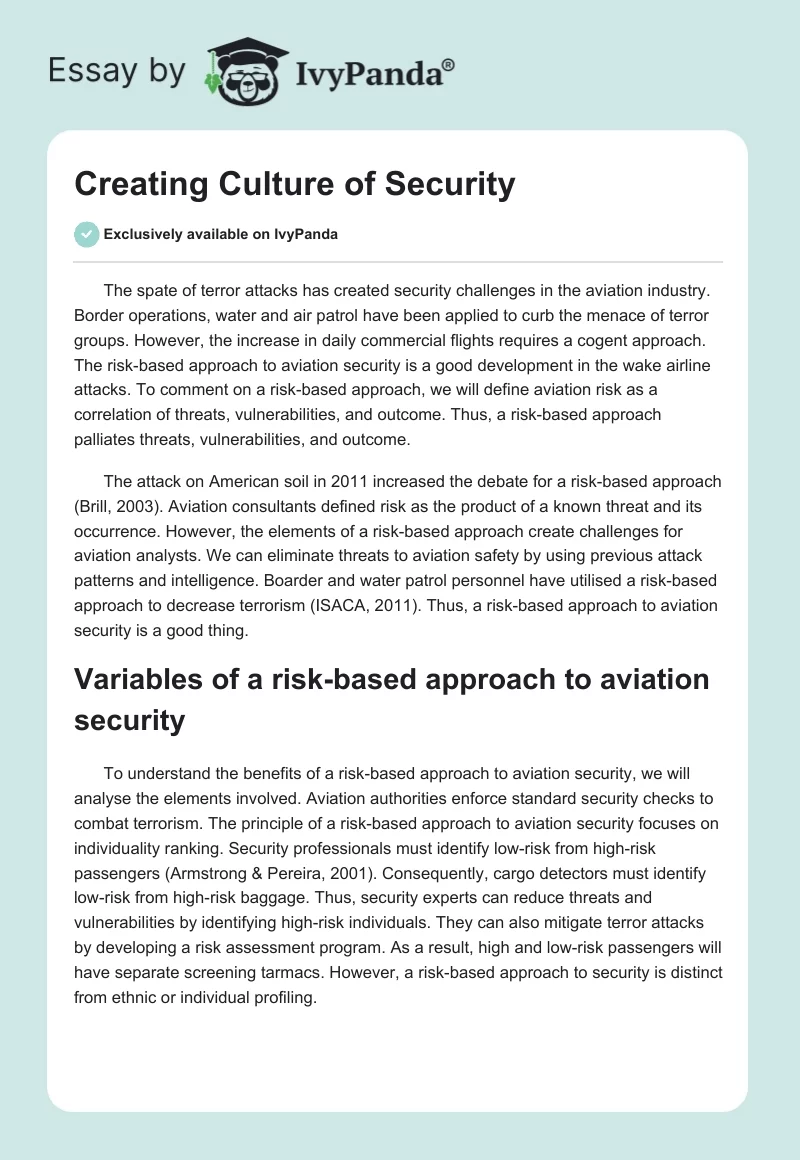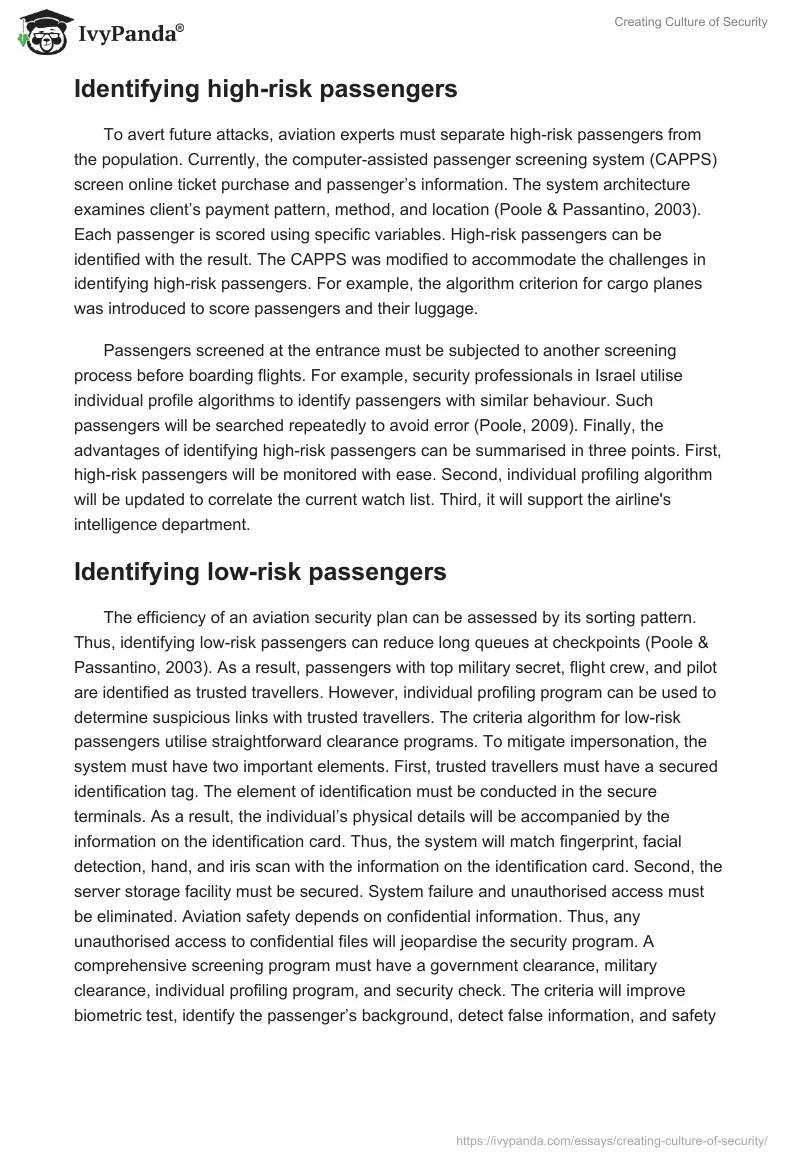The spate of terror attacks has created security challenges in the aviation industry. Border operations, water and air patrol have been applied to curb the menace of terror groups. However, the increase in daily commercial flights requires a cogent approach. The risk-based approach to aviation security is a good development in the wake airline attacks. To comment on a risk-based approach, we will define aviation risk as a correlation of threats, vulnerabilities, and outcome. Thus, a risk-based approach palliates threats, vulnerabilities, and outcome.
The attack on American soil in 2011 increased the debate for a risk-based approach (Brill, 2003). Aviation consultants defined risk as the product of a known threat and its occurrence. However, the elements of a risk-based approach create challenges for aviation analysts. We can eliminate threats to aviation safety by using previous attack patterns and intelligence. Boarder and water patrol personnel have utilised a risk-based approach to decrease terrorism (ISACA, 2011). Thus, a risk-based approach to aviation security is a good thing.
Variables of a risk-based approach to aviation security
To understand the benefits of a risk-based approach to aviation security, we will analyse the elements involved. Aviation authorities enforce standard security checks to combat terrorism. The principle of a risk-based approach to aviation security focuses on individuality ranking. Security professionals must identify low-risk from high-risk passengers (Armstrong & Pereira, 2001). Consequently, cargo detectors must identify low-risk from high-risk baggage. Thus, security experts can reduce threats and vulnerabilities by identifying high-risk individuals. They can also mitigate terror attacks by developing a risk assessment program. As a result, high and low-risk passengers will have separate screening tarmacs. However, a risk-based approach to security is distinct from ethnic or individual profiling.
Identifying high-risk passengers
To avert future attacks, aviation experts must separate high-risk passengers from the population. Currently, the computer-assisted passenger screening system (CAPPS) screen online ticket purchase and passenger’s information. The system architecture examines client’s payment pattern, method, and location (Poole & Passantino, 2003). Each passenger is scored using specific variables. High-risk passengers can be identified with the result. The CAPPS was modified to accommodate the challenges in identifying high-risk passengers. For example, the algorithm criterion for cargo planes was introduced to score passengers and their luggage.
Passengers screened at the entrance must be subjected to another screening process before boarding flights. For example, security professionals in Israel utilise individual profile algorithms to identify passengers with similar behaviour. Such passengers will be searched repeatedly to avoid error (Poole, 2009). Finally, the advantages of identifying high-risk passengers can be summarised in three points. First, high-risk passengers will be monitored with ease. Second, individual profiling algorithm will be updated to correlate the current watch list. Third, it will support the airline’s intelligence department.
Identifying low-risk passengers
The efficiency of an aviation security plan can be assessed by its sorting pattern. Thus, identifying low-risk passengers can reduce long queues at checkpoints (Poole & Passantino, 2003). As a result, passengers with top military secret, flight crew, and pilot are identified as trusted travellers. However, individual profiling program can be used to determine suspicious links with trusted travellers. The criteria algorithm for low-risk passengers utilise straightforward clearance programs. To mitigate impersonation, the system must have two important elements. First, trusted travellers must have a secured identification tag. The element of identification must be conducted in the secure terminals. As a result, the individual’s physical details will be accompanied by the information on the identification card. Thus, the system will match fingerprint, facial detection, hand, and iris scan with the information on the identification card. Second, the server storage facility must be secured. System failure and unauthorised access must be eliminated. Aviation safety depends on confidential information. Thus, any unauthorised access to confidential files will jeopardise the security program. A comprehensive screening program must have a government clearance, military clearance, individual profiling program, and security check. The criteria will improve biometric test, identify the passenger’s background, detect false information, and safety
Identifying ordinary passengers
It is important to categorise ordinary passengers for the mix population. Ordinary passengers can be separated from low and high-risk passengers. Utilising the trusted traveller identification card, security professionals can identify low-risk passengers (Poole, 2009). However, separating ordinary passengers from high-risk passengers require careful examination. The list of high-risk passengers must be updated. Thus, an updated list can be used to identify high-risk passengers. Consequently, waiting rooms can be used to profile high-risk passengers. For example, Boston and Israeli airports have a lobby section that analyses passenger’s behaviour. Thus, aviation safety depends on confidential security information.
Checkpoint design
Redesigning checkpoints to align with a risk-based approach will improve the safety of passengers. As a result, trusted passengers will have a reserved checking point. However, ordinary and high-risk passengers will undergo screening physical screening. Using a risk-based approach to aviation safety, an unidentified passenger is a risk to the airline. Additionally, cargo checkpoints will reduce the hassle with wide-belly planes. Using a risk-based approach, security professionals can combine intelligence and random check (Sullivan, 2008). In contrast to physical checking approach, cargo screening does not require a large holding unit. Thus, the risk-based approach to aviation safety will improve air transportation. As a result, airline security professionals can assess threats, vulnerabilities, and outcome based on the risk-based approach.
A risk-based approach to aviation safety creates reinforcements in two directions. The reinforcements can be positive or negative. The ordinary passenger believes that the hassle factor impedes air transportation. They believe that screening checkpoints increase the waiting time for an important business meeting (Stewart & Mueller, 2008). However, the importance of security checks can only be accepted when it saves life. For example, the recent disappearance of the Malaysian Airline (MF170) points towards a risk-based approach to aviation safety
Positive response to a risk-based approach
Aviation security as an obstacle
Aviation laws and regulations protect the passenger and the airline. As a result, people are forced to obey security protocols at checkpoints and screening terminals. Thus, factors reduce the excesses of terror attacks. For a terror attack to be successful, the organisers must overcome the security protocol. A risk-based approach to aviation safety is a positive reinforcement. High-risk passengers will use other means of transportation to escape arrest. Our airspace will be safer without high-risk passengers.
Aviation security as a necessity
The efficiency of security professionals stimulates our alert system. A secured environment can be achieved when everyone is vigilant. Thus, a risk-based approach to aviation safety will stimulate passenger’s vigilance. As a result, ordinary passengers can respond to a perceived threat by using various alert channels.
Aviation security creates balance
Risk management creates a balance between a security threat and outcome. A risk-based approach will evaluate the security threat, vulnerability, and outcome. As a result, security professional embeds screening protocols in daily transactions. Thus, balance is a positive response to a risk-based approach.
Negative response to a risk-based approach
A risk-based approach to aviation safety creates a negative response. We will summarise the negative reinforcement below.
Aviation security as a burden to security professionals
The objective of an aviation safety program is undermined when an attack is successful. Thus, the burden of aviation safety lies on its officials. To avert impending attacks, a security professional is saddled with the burden of identifying, and eliminating threats. Thus, aviation safety is a negative response to a risk-based approach
Vigilance
Risk-based approach influences vigilance. However, it is harmful when we see every passenger as a threat to national security. As a result, security professional treats every passenger as a threat
The effect of a security watch list
A comprehensive watch list will mitigate aviation attacks. However, it can also create an ethnic profiling program. For example, the terror attacks in the US influenced ethnic profiling. As a result, passengers of Arab origin are subject to harsh scrutiny at military checkpoints and airport terminals. The negative response to a risk-based approach can cause hate among nations.
ICAO council and aviation safety procedures
The International Civil Aviation Organisation is a body that ratifies the principles and practices of safe air transportation. The ICAO develops standard practices and regulations for the aviation industry. As a result, the organisation was established in 1947. The ICAO council is the political wing of the organisation that recommends aviation rules and regulations (International Civil Aviation Organization, 2005). In 2006, the ICAO Council recommended new guidelines against terror attacks and unlawful interference. The recommendations of the ICAO titled Doc 8973, addresses two areas of aviation security. First, threat assessment and intelligence gathering were enforced. Second, security professionals must deploy resources to identify threats, vulnerabilities, and outcome. As a result, the council recommended universal screening practice for passengers, cargo, baggage, air marshals, crewmembers, high-risk passengers, and cockpit security.
The recommendations were adopted using the risk-based approach to aviation safety. In 2007, the ICAO Council recommended safe definitions and procedures to handle security breach. In 2009, amendments were approved on emergency signals, communication procedures, aircraft interception, and cruising levels. The recommendations to speed control, safety signals, and unmanned aircraft were approved in 2012. Changes in aviation rules and regulations are based on new developments in the aviation industry (International Civil Aviation Organization, 2005). The frequency of attacks on civilian aircraft will influence more recommendations to aviation safety standards.
Conclusions
Aviation security procedures and guidelines are enforced to prevent attacks on passengers, cabin crews, and the aircraft. The techniques and recommendations are based on a particular security model. The risk-based approach to aviation safety addresses threat, vulnerabilities, and outcome. As a result, identify high-risk passengers is the objective of the security approach. Thus, an updated list will improve the safety conditions of air transportation. However, the risk-based approach to aviation safety creates a positive and negative response. The burden on security professionals is a negative response to a risk-based approach. The recommendations of the ICAO Council support aviation safety. The ICAO amends aviation guidelines to align with changes in crime control and passenger safety.
References
Armstrong, D. & Pereira, J. (2001). Nation’s airlines adopt aggressive measures for passenger profiling. Wall Street Journal, p. 23.
Brill, S. (2003). After: How America confronted the September 12 era. New York, USA: Simon & Schuster.
International Civil Aviation Organization. (2005). Rules of air. Web.
ISACA. (2011). Creating a culture of security. Web.
Poole, R. & Passantino, G. (2003). A risk-based airport security policy. Web.
Poole, R. (2009). The case for risk-based aviation security policy. World Custom Journal, 3(2), 1-14.
Stewart, M. & Mueller, J. (2008). Assessing the risks, costs, and benefits of United States aviation security measures. Web.
Sullivan, E. (2008). Officials: EU, US agree on air cargo screening. Associated Press. p, 30.


